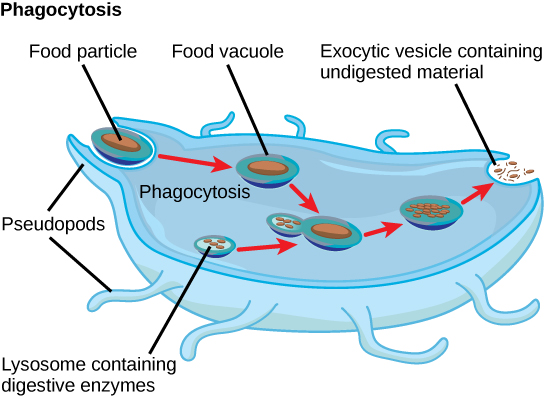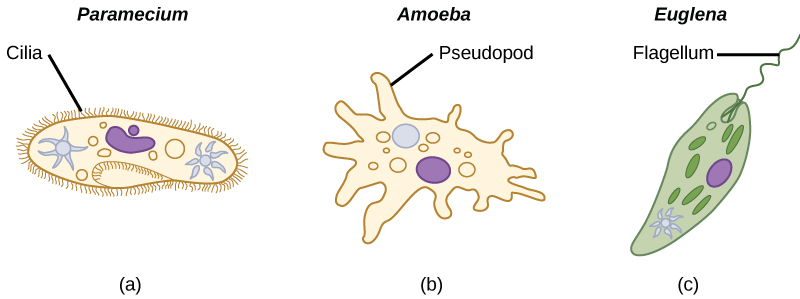What Uses A Whiplike Tail In The Animal Protists
Protists
Characteristics of Protists
OpenStaxCollege
[latexpage]
Learning Objectives
By the terminate of this section, you will exist able to:
- Describe the prison cell structure characteristics of protists
- Describe the metabolic diversity of protists
- Depict the life cycle diverseness of protists
At that place are over 100,000 described living species of protists, and it is unclear how many undescribed species may exist. Since many protists alive as commensals or parasites in other organisms and these relationships are oft species-specific, there is a huge potential for protist diversity that matches the diversity of hosts. Every bit the catchall term for eukaryotic organisms that are not animal, found, or fungi, information technology is not surprising that very few characteristics are common to all protists.
Cell Construction
The cells of protists are amid the virtually elaborate of all cells. Nearly protists are microscopic and unicellular, just some truthful multicellular forms exist. A few protists alive as colonies that acquit in some ways as a group of free-living cells and in other means every bit a multicellular organism. Still other protists are composed of enormous, multinucleate, unmarried cells that wait similar amorphous blobs of slime, or in other cases, like ferns. In fact, many protist cells are multinucleated; in some species, the nuclei are different sizes and have distinct roles in protist cell role.
Single protist cells range in size from less than a micrometer to three meters in length to hectares. Protist cells may exist enveloped by animate being-like cell membranes or constitute-like prison cell walls. Others are encased in burnished silica-based shells or wound with pellicles of interlocking protein strips. The pellicle functions like a flexible coat of armor, preventing the protist from being torn or pierced without compromising its range of motion.
Metabolism
Protists showroom many forms of nutrition and may be aerobic or anaerobic. Protists that shop energy by photosynthesis belong to a group of photoautotrophs and are characterized by the presence of chloroplasts. Other protists are heterotrophic and swallow organic materials (such as other organisms) to obtain nutrition. Amoebas and some other heterotrophic protist species ingest particles past a procedure called phagocytosis, in which the jail cell membrane engulfs a nutrient particle and brings it inward, pinching off an intracellular membranous sac, or vesicle, chosen a food vacuole ([link]). The vesicle containing the ingested particle, the phagosome, then fuses with a lysosome containing hydrolytic enzymes to produce a phagolysosome, and the food particle is broken downward into small molecules that can lengthened into the cytoplasm and exist used in cellular metabolism. Undigested remains ultimately are expelled from the cell via exocytosis.
The stages of phagocytosis include the engulfment of a nutrient particle, the digestion of the particle using hydrolytic enzymes contained inside a lysosome, and the expulsion of undigested materials from the cell.

Subtypes of heterotrophs, called saprobes, absorb nutrients from dead organisms or their organic wastes. Some protists can function equally mixotrophs, obtaining nutrition by photoautotrophic or heterotrophic routes, depending on whether sunlight or organic nutrients are available.
Motion
The bulk of protists are motile, but different types of protists have evolved varied modes of movement ([link]). Some protists take one or more flagella, which they rotate or whip. Others are covered in rows or tufts of tiny cilia that they coordinately beat to swim. Still others course cytoplasmic extensions chosen pseudopodia anywhere on the cell, anchor the pseudopodia to a substrate, and pull themselves frontward. Some protists tin move toward or away from a stimulus, a motility referred to equally taxis. Motion toward light, termed phototaxis, is accomplished by coupling their locomotion strategy with a calorie-free-sensing organ.
Protists use various methods for transportation. (a) Paramecium waves hair-like appendages called cilia to propel itself. (b) Amoeba uses lobe-similar pseudopodia to anchor itself to a solid surface and pull itself forward. (c) Euglena uses a whip-similar tail chosen a flagellum to propel itself.

Life Cycles
Protists reproduce by a diversity of mechanisms. Most undergo some form of asexual reproduction, such equally binary fission, to produce two daughter cells. In protists, binary fission can exist divided into transverse or longitudinal, depending on the axis of orientation; sometimes Paramecium exhibits this method. Some protists such every bit the true slime molds showroom multiple fission and simultaneously divide into many girl cells. Others produce tiny buds that go on to split up and grow to the size of the parental protist. Sexual reproduction, involving meiosis and fertilization, is common among protists, and many protist species tin can switch from asexual to sexual reproduction when necessary. Sexual reproduction is often associated with periods when nutrients are depleted or environmental changes occur. Sexual reproduction may let the protist to recombine genes and produce new variations of progeny that may exist meliorate suited to surviving in the new environment. However, sexual reproduction is often associated with resistant cysts that are a protective, resting stage. Depending on their habitat, the cysts may be specially resistant to temperature extremes, desiccation, or low pH. This strategy also allows certain protists to "expect out" stressors until their surroundings becomes more favorable for survival or until they are carried (such equally past air current, water, or send on a larger organism) to a different surroundings, because cysts exhibit well-nigh no cellular metabolism.
Protist life cycles range from simple to extremely elaborate. Certain parasitic protists have complicated life cycles and must infect different host species at different developmental stages to complete their life wheel. Some protists are unicellular in the haploid class and multicellular in the diploid class, a strategy employed by animals. Other protists have multicellular stages in both haploid and diploid forms, a strategy called alternation of generations that is also used by plants.
Habitats
Nearly all protists exist in some type of aquatic environment, including freshwater and marine environments, damp soil, and even snow. Several protist species are parasites that infect animals or plants. A few protist species alive on dead organisms or their wastes, and contribute to their decay.
Section Summary
Protists are extremely various in terms of their biological and ecological characteristics, partly because they are an artificial assemblage of phylogenetically unrelated groups. Protists display highly varied cell structures, several types of reproductive strategies, virtually every possible type of diet, and varied habitats. Well-nigh unmarried-celled protists are motile, simply these organisms use diverse structures for transportation.
Review Questions
Protists that take a pellicle are surrounded past ______________.
- silica dioxide
- calcium carbonate
- carbohydrates
- proteins
D
Protists with the capabilities to perform photosynthesis and to absorb nutrients from dead organisms are chosen ______________.
- photoautotrophs
- mixotrophs
- saprobes
- heterotrophs
B
Which of these locomotor organs would likely exist the shortest?
- a flagellum
- a cilium
- an extended pseudopod
- a pellicle
B
Alternation of generations describes which of the post-obit?
- The haploid grade tin be multicellular; the diploid course is unicellular.
- The haploid class is unicellular; the diploid grade can exist multicellular.
- Both the haploid and diploid forms can be multicellular.
- Neither the haploid nor the diploid forms can be multicellular.
C
Free Response
Explain in your ain words why sexual reproduction can be useful if a protist's environment changes.
The ability to perform sexual reproduction allows protists to recombine their genes and produce new variations of progeny that may be better suited to the new environment. In contrast, asexual reproduction generates progeny that are clones of the parent.
Giardia lamblia is a cyst-forming protist parasite that causes diarrhea if ingested. Given this information, confronting what type(due south) of environments might G. lamblia cysts exist particularly resistant?
As an abdominal parasite, Giardia cysts would be exposed to low pH in the stomach acids of its host. To survive this environs and achieve the intestine, the cysts would have to be resistant to acidic conditions.
Glossary
- mixotroph
- organism that can obtain nutrition by autotrophic or heterotrophic means, normally facultatively
- pellicle
- outer cell covering composed of interlocking poly peptide strips that part like a flexible coat of armor, preventing cells from existence torn or pierced without compromising their range of motion
- phagolysosome
- cellular body formed by the union of a phagosome containing the ingested particle with a lysosome that contains hydrolytic enzymes
Source: https://pressbooks-dev.oer.hawaii.edu/biology/chapter/characteristics-of-protists/
Posted by: shotwellenbraing.blogspot.com

0 Response to "What Uses A Whiplike Tail In The Animal Protists"
Post a Comment